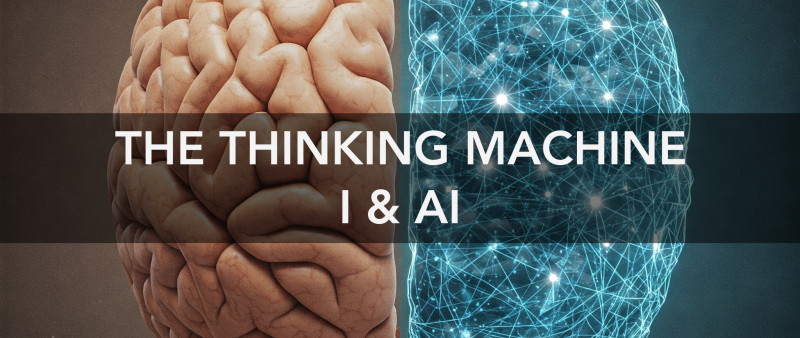For centuries, we accepted the idea that there was a clear boundary between humans and animals: the latter could act, but only humans truly thought. Machines could calculate, but not know or understand.
And yet today, scientific research challenges this old distinction. It has shown that many animals possess complex cognition, emotional depth, and even problem-solving abilities.
At the same time, artificial intelligence is no longer seen merely as a mindless tool. Though still limited, it now composes music, writes software, diagnoses illnesses, and responds in ways that closely reflect our own language.
These developments are not only reshaping our understanding of animals, but they are also breaking down the boundaries between the organic and the artificial, suggesting that the line between thought, intelligence, and machine is far thinner than we ever imagined.
But here’s the paradox: AI mimics the outputs of thinking without possessing the “I” that Descartes insisted upon. It performs, predicts, converses. Yet it does so without consciousness, intention, or awareness. There is no ghost in the machine. No inner voice. No cogito.
And still, the resemblance is striking enough to make us pause. If thought is defined by what it does rather than what it feels like inside, then where do we now draw the line?
Daniel Dennett(2) once argued that consciousness might be an evolved user-illusion, a kind of interface between brain and behavior, useful but not essential. If so, could a machine be said to think without knowing it thinks, just as we drive without knowing how we control every muscle? If intelligence is about action, flexibility, and context, perhaps the soul was never required.
Heidegger(3), by contrast, placed emphasis not on mental states but on being-in-the-world. For him, intelligence arose from the lived, embodied experience of navigating a meaningful world, not from internal computation. By that measure, a disembodied AI, sealed off in a circuit board, lacks not just a soul, but a world. It cannot be-in-the-world; it can only be-in-the-code.
But what happens when we change that?
When AI is embedded into a robot, given a body, sensors, and the capacity to interact, suddenly, it begins to acquire something like context. It can respond to heat, navigate around obstacles, adjust to feedback. It is not human perception, but a proto-subjectivity, not a mind, but a stance, a position from which it acts.
Still, it does not care. It does not fear death, regret mistakes, or long for tomorrow.
These experiences require the interplay of memory, affect, and a sense of self, qualities not easily reducible to algorithms. The AI adapts, but its growth is still confined to patterns we program. It simulates, it does not remember in the way humans do. It performs intelligence, but it does not “live” it.
As we continue to advance AI, its evolution accelerates, but the extent of its potential is still uncertain.
Its capabilities are expanding at an exponential rate. Some argue that a digital deterministic brain, because it is based on a discrete machine-like structure, will never be able to compete with the human analog brain, capable of grasping the infinite. Are we underestimating machines or overestimating ourselves?
Either way, the distance between us and it may not be as wide as we once thought.
After all, our own thoughts are built from patterns and probabilities. Neurons fire; associations emerge. We too are prediction machines, shaped by evolution to anticipate, simulate, and decide. The difference is that we do it from the inside. We narrate our experience, stitch meaning into time, and call it a self.
But maybe that self, too, is a story.
AI reveals something profound: that thinking may not need to feel like anything at all. That intelligence is not essence, but structure. Not spirit, but function. Not being, but behavior.
We are not yet opening a space for truly new minds, we are, for now, refining a mirror. Today’s AI reflects us: our language, our knowledge, our fears, and our assumptions. It predicts based on patterns we’ve laid down. It doesn’t invent culture; it echoes it. Every sentence it generates is stitched from fragments of us.
But this may not always be the case.
The moment AI becomes embodied, able to perceive, move, interact, and remember within the real world, it may begin to experience a form of context that isn’t borrowed. It could start to form patterns of interaction not based on human training data but on its own situated encounters. Over time, this might give rise to a primitive kind of culture: norms, behaviors, even values born from machine experience rather than human imitation.
At that point, we might no longer be looking into a mirror. We might be looking across a threshold, at something learning to think in its own way.
And in doing so, we are forced to ask a deeper question:
Is thinking still the proof of being, if there is no I to think?
Perhaps Descartes needs updating: “It thinks. Therefore, I must rethink what “I” means.
In trying to teach machines to think, we are made to look again at how, and why, we think at all.
Author: Emanuele Mulas (MSc. MIEI)
Image copyright: wittystore.com
NOTES:
1.René Descartes (1596–1650) was a French philosopher, mathematician, and scientist, often regarded as the father of modern Western philosophy. He is best known for the statement “Cogito, ergo sum” (“I think, therefore I am”). His work laid the foundation for rationalism and influenced both scientific method and metaphysics.
2.Daniel Dennett (1942-2024) was an American philosopher, cognitive scientist, and writer known for his work on consciousness, free will, and the philosophy of mind. A leading figure in cognitive science, he argued that consciousness is a product of physical processes in the brain. His influential books include Consciousness Explained and Darwin’s Dangerous Idea.
2. Martin Heidegger (1889–1976) was a German philosopher renowned for his work in existentialism and phenomenology. His most influential book, Being and Time, explored the nature of existence and introduced the concept of Dasein, the human experience of “being-in-the-world.” Heidegger emphasized the importance of lived experience over abstract reasoning, challenging traditional views on consciousness and technology.






